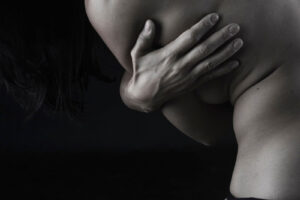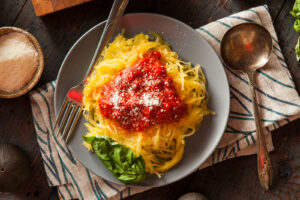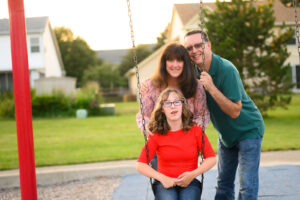Patricia Markos Dolan
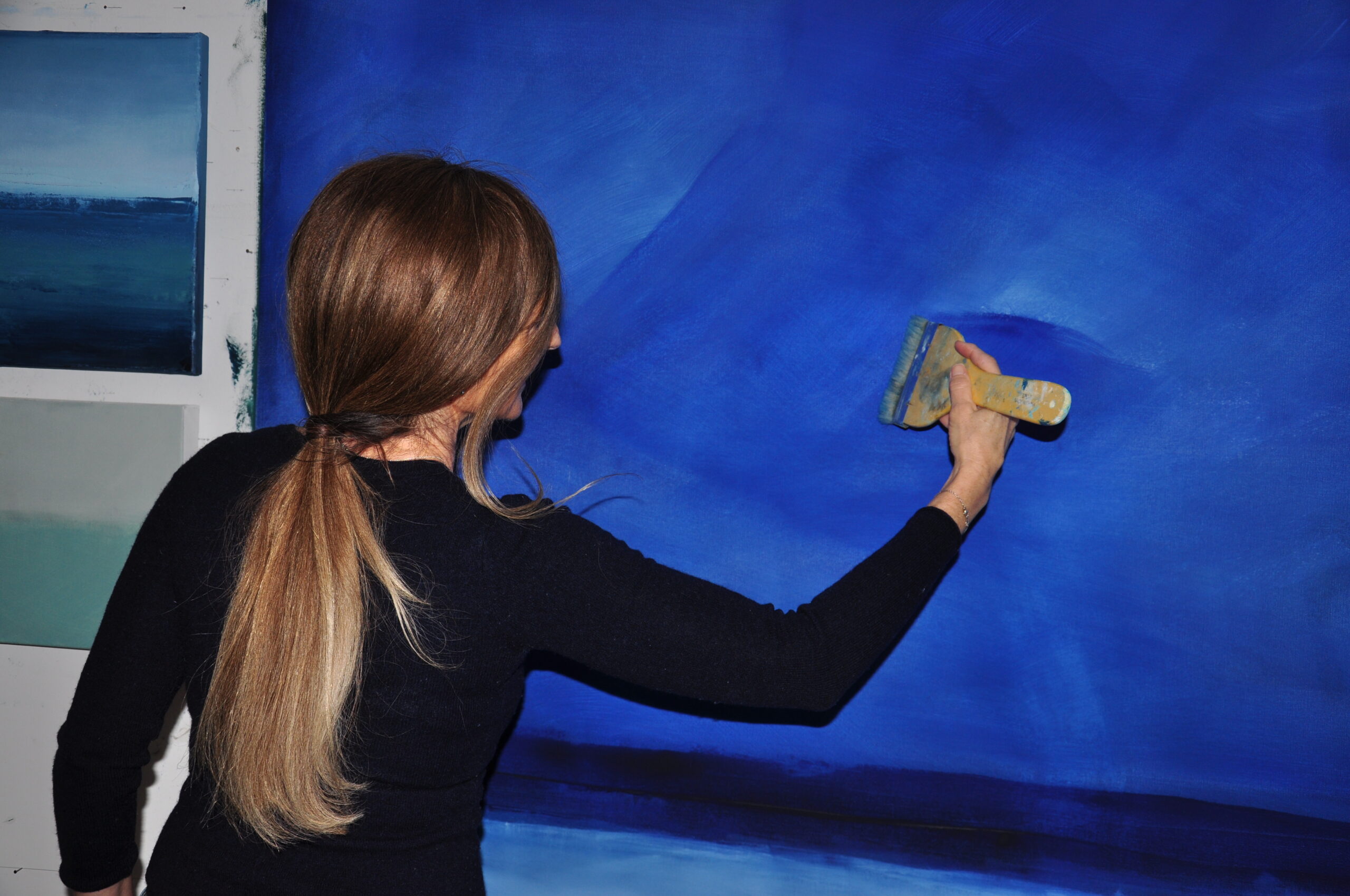
“I always tell my children: Look at your journeys as white canvas. You can create what you want,” says artist Patricia Markos Dolan. “In creating, be open to the universe and allow it to speak to you.” Dolan’s works have been in group and solo exhibitions for more than a decade. Taking a message from the universe, she finds inspiration for her pieces from her Greek heritage juxtaposed with her current home of Winnetka, Illinois.
“Greek was my first language; it was my core,” she says. “At my present moment, I’m in a different culture, [but] all cultures are fused together. We’re all the same, and that’s what makes us one. So on the canvas is where it becomes one for me.” Gazing at one of Dolan’s paintings hanging on a gallery wall is an experience unique to each person, allowing them to tell their own story of love or grief, joy or pain. “As we experience life, all our challenges, our love, our loss, everything, will put us in a deeper consciousness,” Dolan says. “As I work with my paint on the canvas, it starts taking its own form, its own story — It’s void of any human presence. It allows the individual to place themselves in their own existence.”
This spring, Dolan has decided to donate the proceeds of one of her paintings to the Hippocratic Cancer Research Foundation (HCRF). “When creating the piece, I felt the optimism and the power of now through visual and emotional healing, allowing our internal positive voice to surface,” Dolan says. The piece — “Θετικα,” Thetika — means “Positively,” according to Dolan, and her donation to HCRF reflects the organization’s “commitment to relentless research in discovering breakthrough treatments through holistic approach to integrate the full spectrum of cancer from all angles,” she says. “Their innovative approach is incredible and inspired me to bring Θετικα into existence.”
Christine Wilson
“Art helps us to accept and explore our emotions, to embrace our choices, foster self-compassion, connect with others, discover how we feel to alleviate stress and create calm in our life. Whether it’s in a journal, on a canvas or drawing with chalk on a sidewalk with the kids, taking that time each day to stop, breathe, be mindful and reconnect with yourself will help heal the mind, body and spirit.” — Christine Wilson
Christine is a licensed medical massage therapist based in Saint Charles, Missouri. Through her work, she has seen how stress manifests in the body, and promotes the value of self-care to help manage her clients’ stress and anxiety. This became all too important in Christine’s personal life when she was diagnosed with breast cancer in the spring of 2019. “I had many breast cancer clients, so I didn’t ask ‘Why me?’ I knew the odds,” Christine says. “I needed to take a hard look at how I handled stress and how I took care of myself.”
Christine knew the most important part of self-care is making time to do something that brings you joy. “For me, that was painting,” she says. She taught herself how to watercolor paint a few years earlier as an outlet to help manage her mental health — “[It was] a healthy outlet for bad dating and my hospice work,” she says — but she struggled to find this inspiration during cancer treatment. Her therapist told her to give it time, so Christine continued to watch art-making videos and treated herself with art supplies after radiation sessions.
“After treatment was done, I literally made myself sit down at my art table and put a brush in my hand, [because] you have to start somewhere,” Christine says. “I needed to find that spark again. It doesn’t have to be a masterpiece; simply just enjoy the process. And do you know what happened? Yes, of course I started to paint again.”
She was surprised to find that her cancer experience had led to an evolution in her artistic journey. “It became apparent that nothing made sense to me anymore, so I developed more of an abstract style and kicked perfection to the curb,” she says. “This became a healing process for me and is reflected in my art work today.”
Christine believes good health inspires creativity, and she is now using her experience as a therapist and mixed-media artist to encourage and support others. She owns an art studio in her hometown of Saint Charles, called Heart Centered Studios, where she hosts art-making classes with an aim to decrease stress and anxiety while promoting mindful self-care. “Like a butterfly, we transform, spread our wings and share our beauty with others,” she says.
To learn more about Christine and her studio, visit HeartCenteredStudios.com or visit her on Instagram @christine.wilson.art
Mandi Chambless
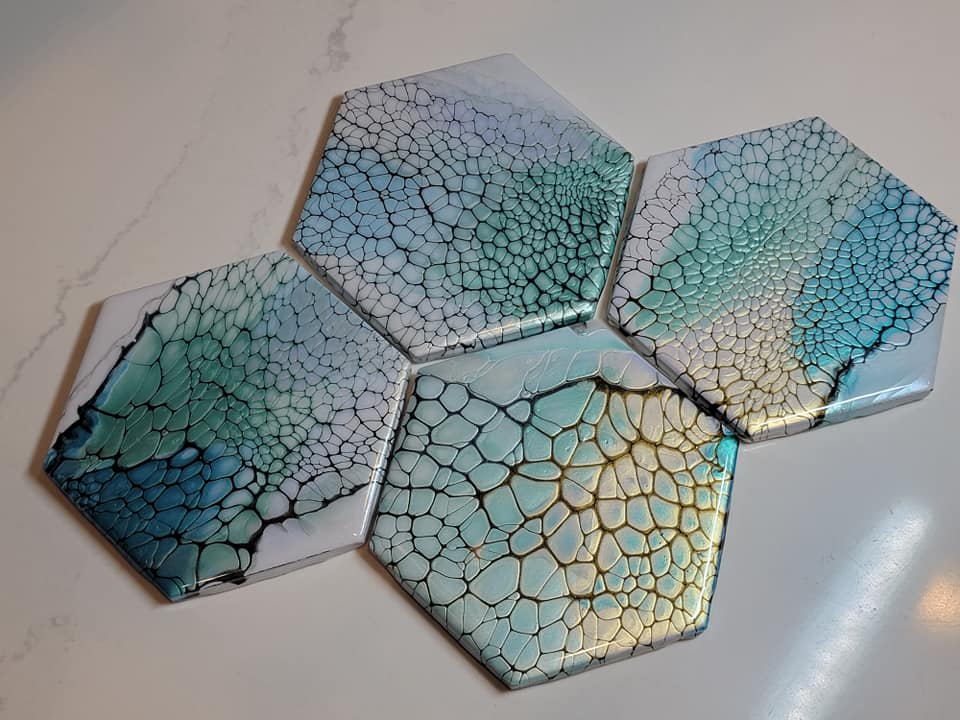
In 2009, at just 28 years old, Mandi Chambless was diagnosed with stage IIIC ovarian cancer. Her doctors told her she had a 20% chance of surviving five years, but 14 years later, Mandi is still here, fostering her creativity through writing and creating art.
Mandi was always artistic, but painting became an avenue for healing following her cancer diagnosis. “I needed a healthy outlet to relieve stress as well as distract my brain and body in a more productive way,” Mandi says. “I find that redirecting my focus to creating something beautiful for someone else to love allows me to relax, accept and forget. It’s my escape.”
Creating became even more necessary in 2021, when Mandi experienced what she thought was a cancer recurrence. Mandi’s scans came back clean, but she documented the tumultuous time with a series of personal essays, which she published as part of cW’s Slice of Life essay series. Meditating on strong feelings through the act of writing can help cancer thrivers and survivors manage the negative mental health effects of their cancer journey. This was true for Mandi, as she found solace in offering a glimpse into the life of a cancer survivor, so others could maybe feel less alone when faced with similar circumstances.
Mandi has been focusing her visual art practice on “fluid art” over the past few years. Her “bloom technique” creates abstract cells and lacing across the surface of her canvas — lately, she’s been creating one-of-a-kind homeware pieces and accessories with this technique. “I love the fact that the process is partially defined by a lack of control of the way the paints interact, blend and spread,” she says. “There’s so much in this life that we fight to manage, and knowing that the end result of my art isn’t completely up to me frees me up to be playful and experimental. […] Relinquishing control can be liberating.”
Learn more about Mandi and view her latest pieces on her Instagram @chamblessmandi, and read Mandi’s three-part essay series, “Tomorrow I’ll Know,” at CancerWellness.com.
Kelsey Townend

“Cancer survivors, I see you; I feel you and understand you, even when I don’t understand this process, there is an unspoken bond between those who have come close to death and survived, I think, because we all know the reality of surviving can carry some heaviness.
They should give us a little heads up about this in the chemo debrief, or maybe they don’t on purpose, because it’s something you can’t quite articulate with words, but I know when I meet another survivor, without a spoken word, it can be felt.”
— Kelsey Townend
In February 2016, Kelsey was diagnosed with stage II choriocarcinoma at 30 years old. She had two young children, but she would have to leave them at home for four long months to receive treatment at the Cross Cancer Institute in Alberta, Canada. “I shaved my head before my hair started to fall out, [which was] my attempt to keep something in my own control,” Kelsey says. Aggressive treatments would allow the greatest chance of survival, but Kelsey, missing her children, wondered, “What kind of survival is it?”
She finished treatment and returned home with emotions that were hard to manage. “What they don’t tell you is what happens in life after cancer,” she says. “There was no going back to anything normal. I felt so angry and sad, as if a large part of who I was before my cancer was gone.” But the memory of everything she had been through reminded her that she was a survivor. “I don’t deserve to be angry, sad, depressed, anxious; I should be making the most out of every single moment I have, [because] they’re all borrowed,” Kelsey says.
During treatment, Kelsey says she was “too ill to do anything beyond survive,” but once back in her hometown she started a cancer sharing circle called The Karuna Group. Soon after, during a long family road trip, she started doodling to create a logo for the group. “I was shocked by how quickly my creative side took hold of me,” she says. She continued making art after vacation, and painting became a way for her to release the emotions she couldn’t articulate with words. “Through painting, I was able to release my sadness, my anger and my frustration that had built up over the course of my treatment.” Painting, Kelsey says, “created a safe space for me and brought me a peace I couldn’t find anywhere else.”
Residual treatment side effects like chronic pain can sometimes prevent Kelsey from creating art, but the promise of a blank canvas keeps her spirits up. “I love painting, because although there are definitely days where I cannot paint due to a bad pain day, I am able to create with no timeline; I can paint at my own pace,” she says. “When I finish a piece, I step back, I see the darkness around the areas where I experience most of my pain and the lightness in areas I so desperately want to show the world. […] I think that during treatment, I came close to death, more than once, and to survive, I had to leave pieces of myself behind. When I paint, I feel like I am slowly putting some of those pieces back.”
Visit Kelsey on Instagram @iamlifeaftercancer
Words by Joely Serino @beautifulmesspoetess
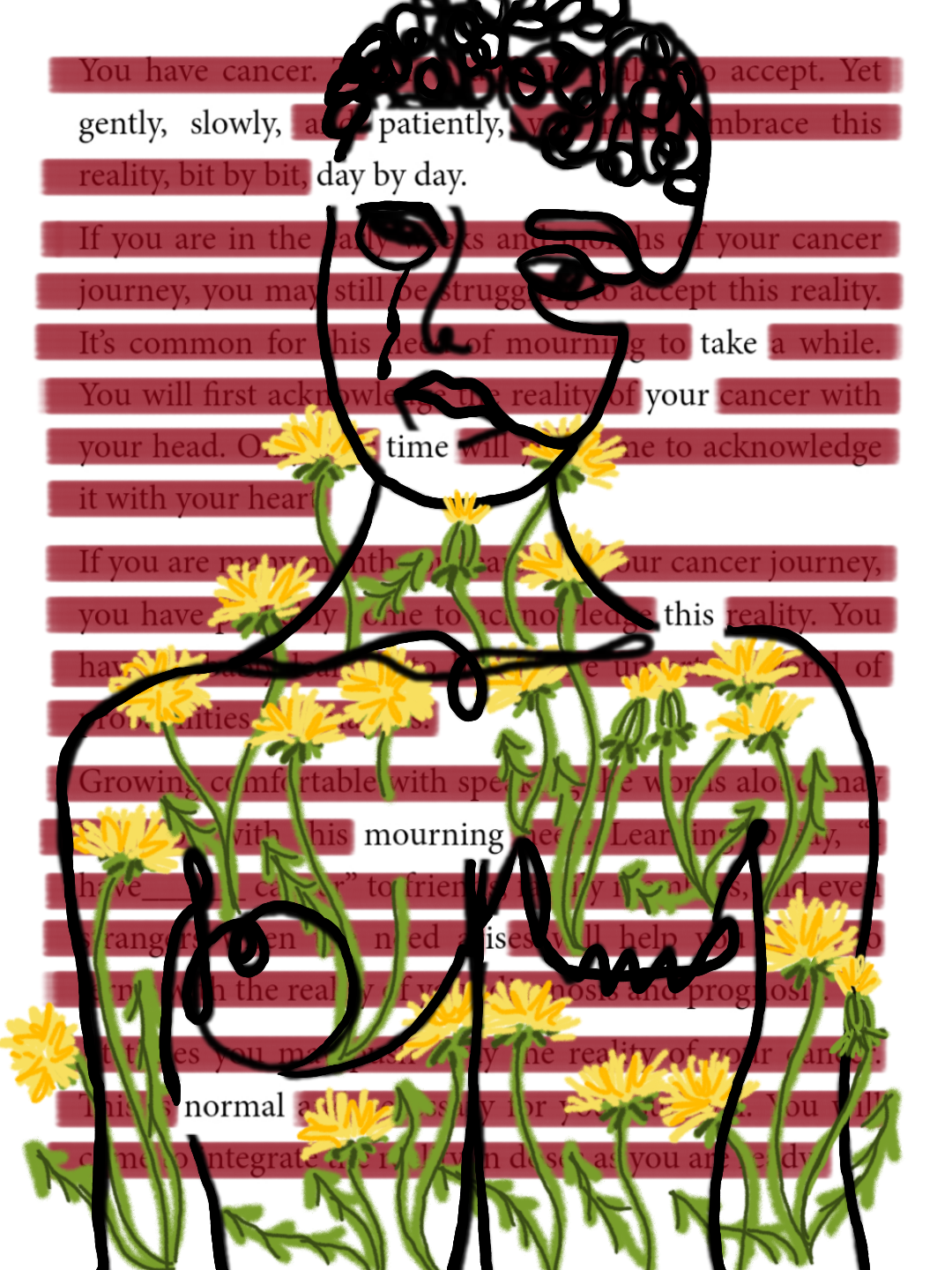
Words have always been my best friends. For as long as I can remember, purging my feelings and turning them into poetry soothed and relieved me from anxiety and the effects of chronic illness. Sharing my poems on social media over the past few years has been cathartic. I immediately feel less alone because I know there is someone who can connect with my words.
After I was diagnosed with invasive ductal carcinoma, I knew I needed to once again lean on my poetry to get me through the mental battle of cancer. I wrote every day about the pain, about feeling alone, about hair loss, about chemotherapy and radiation, about the fear of recurrence. It just spilled out of me, each poem like a therapy session, freeing me from mental and physical anguish. However, quickly into survivorship, I started to notice that my ability to write poetry was being stolen by a chemically induced writer’s block — what is often called “chemo brain.” I just couldn’t find the words anymore.
I couldn’t lose my best coping mechanism. I couldn’t just lay my creativity and love of poetry aside, knowing that it was the best way to protect my mental health. So I started writing blackout poetry. This is when you redact words from a piece of text, like a page from a book or a magazine article, and what’s left forms a micro poem. When I can’t write my own words, I borrow them from the pages of books. After I have chosen which words to leave on the page, I black out the rest of the text with artwork that captures the same emotion. Learning how to add illustrations to my blackout poems also helped me feel accomplished again.
My blackout poems usually discuss cancer, living with chronic pain and illness, mental health, or navigating my way through survivorship. I’ve been able to connect with so many other cancer survivors who feel seen in my work. We relate over the sentiment and artwork that each poem portrays, teaching me that creating is a way to bring people together. It has also taught me that we, as cancer patients, can do what we loved before; we might do it a little differently, but maybe with even better results in the end. While I may always struggle with writer’s block, I will never stop writing poetry; I bleed ink. My poetry just looks a little different now. Some may say it’s even better.
Follow Joely on Instagram: @beautifulmesspoetess
“Finding Strength in Flowers” by Kathleen Castagnoli, AIFD, CCF

From playing among my grandmother’s Sterling Silver rose bushes to being awestruck by a florist who visited my kindergarten class, flowers inspired me from a young age. While I ultimately pursued a career in journalism, my love of flowers never wavered.
When I got burnt out on writing, I decided to take a floral design course at a local community college, and it changed my life. I delved headfirst into flowers and never looked back. I eventually began my own freelance floral design business, specializing in weddings and events; started competing in floral design competitions; and set my sights on higher certifications, namely with the American Institute of Floral Designers (AIFD) and the California State Floral Association (CCF).
It was the evening after I designed a wedding with over 200 guests that I discovered the coughing, body itching and crappy feelings were not actually symptoms of COVID-19, but stage II non-Hodgkin’s lymphoma. To say I was in complete and utter shock was an understatement.
I was officially diagnosed on Nov. 1, 2021, and from there experienced complication after complication — from an infection in my chemotherapy port to blood clots in both arms to fluid buildup in my lung. Because of this, I endured many procedures in addition to week-long hospital stays for my treatments, at times receiving up to five different injections in my stomach per day.
Although I couldn’t practice floral design for some time, I missed flowers. I missed getting up at 3 am to hit the Los Angeles Flower Market, putting together bouquets and centerpieces for weddings. Mostly, I missed the ability to be creative and design something beautiful.
So I signed up for a virtual floral class on color theory taught by a few of my mentors. It was a struggle, but I managed to complete one of the student projects. My wife, Kylie, brought in the bouquet I designed so I could enjoy it in my hospital room, where it received many compliments from my nurses. I remember nighttimes being hooked up to chemo and watching my floral class on an iPad in my hospital bed. Taking part in this class brought a sense of normalcy and brightness to my long and sometimes lonely medical-filled days.
Toward the end of treatment, I was invited by a luxury traveling floral company, Fleurs de Villes, to be one of their featured florists and design a mannequin as part of their “Femme” show highlighting notable women in history. Fleurs de Villes was something I had longed to be part of, but I didn’t know if I would feel well enough or have the stamina to put such a massive floral installation together on my own.
I called one of my best florist friends, Tee Dryer-Torres, and asked for help. From loaning me the use of her floral studio and supplies, to helping me install late into the night, I still get tearful thinking about all that Tee, Kylie and other florist friends did to help bring my female Native American chief, Coronne, to life.
While I’m grateful to say that I am now in remission, cancer has forever changed me. While I may have won the battle for my health, the mental and financial war is far from over. My advice to fellow cancer survivors and thrivers is to be patient and kind with yourself. Getting “back to normal” feels like a fallacy to me; in reality, it’s more about figuring out what’s next. And as I’m starting to learn, there’s absolutely nothing wrong with that.
At the same time, I am forging a new path in my floral journey, perhaps doing fewer weddings and more floral instruction and artistry. Designing and creating flowers — not just for others but for myself as well — helps me heal and continues to inspire that little girl who still loves Sterling Silver roses.
Kathleen Castagnoli, AIFD, CCF, is an accomplished writer, editor and floral designer in Huntington Beach, California. In addition to playing with words and flowers, Kathleen is a coffee aficionado and hockey fanatic, and she loves spending time with her wife Kylie, their 15-year-old son Max and their spoiled puppy Mocha Bean.


